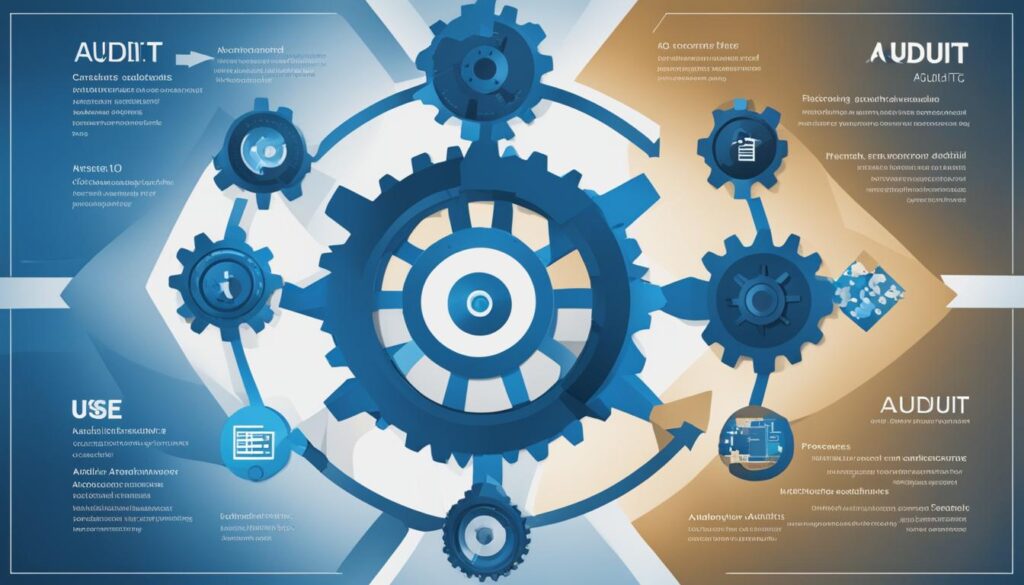Welcome to our article on the important role of an Information Technology Auditor. In today’s digital age, organizations heavily rely on technology to streamline their operations and achieve their business objectives. However, with increasing reliance on technology comes the need for proper governance, security, and compliance measures. This is where an Information Technology Auditor comes in.
An Information Technology Auditor is a skilled professional who plays a crucial role in ensuring the security, efficiency, and compliance of an organization’s IT infrastructure. They have the expertise to examine hardware, software, systems, and networks to ensure they align with business objectives and regulatory requirements. Their responsibilities include assessing system controls, evaluating risks, verifying data integrity, and reviewing IT governance processes.
IT auditors also play a vital role in identifying vulnerabilities in IT systems and providing strategic recommendations for improvement. By conducting comprehensive audits, they help organizations identify potential risks and implement measures to mitigate them effectively. With their valuable insights, businesses can enhance their IT systems’ efficiency, protect sensitive data, and ensure smooth operations.
Contents
- 1 The Importance of IT Audits for Businesses
- 2 Types of IT Audits and Their Significance
- 3 Overcoming Challenges in IT Audits
- 4 Preparing for an IT Audit
- 5 Conclusion
- 6 FAQ
- 6.1 What is an information technology auditor?
- 6.2 What are the roles and responsibilities of an IT auditor?
- 6.3 Why are IT audits important for businesses?
- 6.4 What types of IT audits exist?
- 6.5 What is the IT audit process?
- 6.6 How can IT auditors overcome challenges in their field?
- 6.7 How should businesses prepare for an IT audit?
- 6.8 How long does an IT audit take and how much does it cost?
- 6.9 How often should a business have an IT audit?
- 7 Source Links
Key Takeaways:
- An Information Technology Auditor is responsible for ensuring the security, efficiency, and compliance of an organization’s IT infrastructure.
- They assess system controls, evaluate risks, verify data integrity, and review IT governance processes.
- IT auditors identify vulnerabilities in IT systems and provide strategic recommendations for improvement.
- Regular IT audits help businesses protect their assets, mitigate IT risks, and align their IT systems with strategic objectives.
- IT auditors play a crucial role in the success and sustainability of organizations in today’s digital landscape.
The Importance of IT Audits for Businesses
IT audits play a crucial role in today’s digital landscape. With the increasing dependence on technology, businesses must ensure the security, efficiency, and compliance of their IT systems. Conducting regular IT audits allows organizations to evaluate their technology infrastructure, identify security risks and vulnerabilities, and align their IT systems with strategic business objectives.
One of the primary benefits of IT audits is their ability to assess the internal controls in IT auditing. Internal controls are the policies, procedures, and practices that organizations implement to safeguard their assets, mitigate risks, and ensure the accuracy and reliability of financial reporting.
By reviewing these controls, IT auditors help businesses identify gaps and weaknesses that could potentially lead to financial losses, data breaches, or regulatory noncompliance. Through comprehensive assessments, auditors can provide recommendations for strengthening internal controls, promoting efficient operations, and protecting corporate assets.
Another key aspect of IT audits is their role in ensuring compliance with regulations and industry standards. Businesses must comply with various laws and regulations related to data privacy, information security, and financial reporting. Noncompliance can result in severe penalties, reputation damage, and legal consequences. IT audits help organizations stay ahead of regulatory changes, assess their compliance posture, and take corrective actions to address any identified gaps.
Furthermore, IT audits help businesses identify and mitigate IT risks, which can include cyber threats, system vulnerabilities, data breaches, and IT operational inefficiencies. By proactively identifying and addressing these risks, organizations can enhance the effectiveness and security of their IT operations, thereby protecting their valuable data and minimizing the potential impact of breaches or disruptions.
Obtaining IT audit certification is a valuable step for professionals in this field to enhance their qualifications and expertise. It demonstrates a solid understanding of IT auditing principles, methodologies, and best practices. Certified IT auditors have the knowledge and skills to effectively evaluate IT systems, identify areas for improvement, and provide strategic recommendations that align with organizational goals.
According to the Information Systems Audit and Control Association (ISACA), obtaining IT audit certification, such as Certified Information Systems Auditor (CISA), validates the auditor’s competence, credibility, and commitment to professional excellence.
To summarize, IT audits are essential for businesses as they assess internal controls in IT auditing, ensure compliance with regulations, identify and mitigate IT risks, and promote the efficient use of IT resources. By obtaining IT audit certification, professionals can further enhance their capabilities and contribute to the success and security of the organizations they serve.
Types of IT Audits and Their Significance
When it comes to IT audits, there are various types that focus on different aspects of an organization’s IT environment. Each type of audit is tailored to address specific risks and requirements based on the nature of the business, industry, and regulations in place.
- Systems and Application Audits: These audits assess the effectiveness of an organization’s IT systems and applications, ensuring they are secure, reliable, and aligned with business objectives.
- Information Processing Facilities Audits: This type of audit evaluates the physical security measures and controls in place to protect an organization’s information processing facilities.
- Systems Development Audits: These audits review the processes and controls involved in the development and implementation of IT systems to ensure they are efficient, secure, and meet business requirements.
- IT Governance and Management Audits: These audits focus on assessing the governance and management practices surrounding IT operations, including IT strategy, risk management, and compliance.
- Network Infrastructure Audits: This type of audit examines an organization’s network infrastructure, including its design, configuration, and security measures, to ensure optimal performance and protection against potential threats.
- Cybersecurity Audits: These audits assess the effectiveness of an organization’s cybersecurity controls and measures, identifying potential vulnerabilities and recommending improvements to protect against cyber threats.
- Data Analytics Audits: This type of audit leverages data analytics techniques to examine large volumes of data and identify patterns, anomalies, or insights that could impact an organization’s IT systems and operations.
IT auditors follow a structured audit process to ensure thoroughness and accuracy in their assessments. This process typically includes:
- Planning: Defining the scope of the audit, identifying key areas to examine, and creating an audit plan.
- Fieldwork/Data Gathering: Collecting relevant data, conducting interviews, and performing tests to gather evidence.
- Analysis: Analyzing the collected data, identifying risks and areas for improvement, and evaluating the effectiveness of controls.
- Reporting: Documenting the audit findings, highlighting any issues or deficiencies, and providing recommendations for remediation.
- Follow-up: Monitoring the implementation of recommended improvements and ensuring that corrective actions have been taken.
The career path for IT auditors offers opportunities for growth and advancement in the field of IT auditing. As organizations continue to prioritize cybersecurity and regulatory compliance, the demand for skilled IT auditors is on the rise. IT auditors can progress from entry-level positions to more senior roles, such as IT Audit Manager or Director. Professional certifications such as Certified Information Systems Auditor (CISA) or Certified Internal Auditor (CIA) can enhance an auditor’s qualifications and open doors to new career opportunities.

Overcoming Challenges in IT Audits
IT audits are essential for businesses to ensure the security and efficiency of their IT systems. However, conducting successful audits can be challenging due to various factors. In this section, we will discuss the common challenges that auditors face during IT audits and explore effective strategies to overcome them.
Knowledge Gap between IT Personnel and Auditors
One of the major challenges in IT audits is the knowledge gap between IT personnel and auditors. Auditors may not possess in-depth technical knowledge, while IT professionals may lack the expertise to understand audit requirements. This gap can result in miscommunication and hindrances during the audit process.
To bridge this knowledge gap, ongoing education and training are crucial. Auditors should continually update their knowledge of IT systems and emerging technologies. Similarly, IT personnel should familiarize themselves with audit methodologies and regulatory requirements. This mutual understanding will enhance collaboration and ensure a comprehensive audit.
Resistance to Audits within the Organization
Another challenge in IT audits is resistance within the organization. Some employees may perceive audits as intrusive or disruptive to their daily operations. This resistance can lead to limited cooperation and hinder the effectiveness of the audit.
Creating an environment that values the importance of audits is essential to overcome this challenge. By promoting a culture of transparency and accountability, organizations can help employees understand the benefits of audits. Involving staff in the audit process, such as providing opportunities for feedback and communication, can foster cooperation and cooperation.
Data Security Concerns
Data security concerns pose significant challenges in IT audits. With the increasing prevalence of cyber threats, ensuring the confidentiality and integrity of data collected during audits is crucial.
To address data security concerns, auditors must adhere to data protection regulations and use secure data collection methods. Implementing encryption and anonymization techniques can help safeguard sensitive information. Additionally, conducting regular security assessments of audit tools and software can further enhance data protection measures.
Managing the Volume of Data
In today’s digital age, businesses generate and store vast amounts of data, making it challenging for auditors to analyze and process this information effectively.
Employing automated audit tools and software can streamline the auditing process and help manage the volume of data more efficiently. These tools can perform data analysis, identify anomalies, and generate comprehensive reports. Auditors can concentrate their efforts on interpreting data insights and providing valuable recommendations.
To summarize, IT audits may encounter challenges such as a knowledge gap between IT personnel and auditors, resistance to audits within the organization, data security concerns, and managing the volume of data. By implementing strategies such as ongoing education and training, creating a culture that values audits, prioritizing data security, and utilizing automated audit tools, businesses can overcome these challenges and conduct successful IT audits.
| Challenges in IT Audits | Strategies to Overcome |
|---|---|
| Knowledge gap between IT personnel and auditors | Ongoing education and training for both auditors and IT personnel |
| Resistance to audits within the organization | Create a culture that values audits and involves staff in the process |
| Data security concerns | Adhere to data protection regulations and use secure data collection methods |
| Managing the volume of data | Employ automated audit tools and software |
Preparing for an IT Audit
Getting ready for an IT audit is essential for ensuring a smooth and successful process. By understanding the scope and purpose of the audit, communicating with auditors, and organizing the necessary documentation, you can be well-prepared to demonstrate your company’s compliance, security, and efficiency.
When preparing for an IT audit, consider the following steps:
- Understand the scope and purpose: Gain clarity on what the audit will cover and the specific objectives it aims to achieve. This will help you focus your efforts and gather the right information.
- Communicate with auditors: Establish clear lines of communication with the auditors to align expectations, address any questions or concerns, and ensure a smooth collaboration throughout the audit process.
- Organize documentation: Gather and organize the necessary evidence and documentation that auditors may require for the auditing process. This may include policies and procedures, system documentation, access controls, system and activity logs, and network diagrams.
- Involve appropriate personnel: Identify the key individuals who should be involved in the audit process. They can provide valuable insights, answer auditors’ questions, and help facilitate access to relevant systems and information.
- Conduct a self-assessment: Perform a thorough self-assessment of your IT infrastructure, systems, and controls. Identify any potential areas of concern and address them proactively before the audit.
- Ensure clear communication: Maintain open lines of communication with auditors throughout the process. Transparent communication ensures that any issues or challenges can be promptly addressed, leading to a more efficient and effective audit.
It’s important to note that the duration and cost of an IT audit depend on various factors, such as the complexity of your IT environment and the scope of the audit. While some audits may take a few days to complete, others may be more extensive and require a longer timeframe.
As for the frequency of IT audits, there is no one-size-fits-all answer. The frequency depends on industry regulations, business needs, and the level of risk involved. Some organizations may opt for annual audits, while others may require more frequent assessments to ensure ongoing compliance and security.

Conclusion
IT audits are invaluable for businesses of all sizes and industries. By conducting regular IT audits, you can protect your digital infrastructure and confidential data, identify potential risks, and ensure compliance with industry regulations. These audits provide crucial insights into your IT systems, enabling you to make informed decisions and enhance the overall efficiency and security of your organization.
One of the key benefits of IT audits is their ability to safeguard your assets. By thoroughly evaluating your systems, networks, and software, IT audits help mitigate the risk of cyber threats, data breaches, and unauthorized access. Additionally, IT audits assist in aligning your IT systems with your strategic objectives, ensuring that your technology infrastructure supports your business goals and enhances productivity.
Another advantage of IT audits is the valuable recommendations they provide. Skilled IT auditors evaluate your current processes and controls, offering actionable suggestions for improvement. These recommendations can help you streamline operations, enhance data integrity, and optimize your IT governance processes.
In conclusion, incorporating IT audits into your business practices is essential for protecting your organization, improving efficiency, and ensuring regulatory compliance. By addressing potential vulnerabilities and implementing recommended improvements, you can maximize the benefits of your IT systems, ultimately contributing to the long-term success and stability of your business.
FAQ
What is an information technology auditor?
An information technology auditor is a professional who plays a crucial role in ensuring the security, efficiency, and compliance of an organization’s IT infrastructure. They examine hardware, software, systems, and networks to ensure they align with business objectives and regulatory requirements.
What are the roles and responsibilities of an IT auditor?
The responsibilities of an IT auditor include assessing system controls, evaluating risks, verifying data integrity, reviewing IT governance processes, identifying vulnerabilities in IT systems, and providing strategic recommendations for improvement.
Why are IT audits important for businesses?
IT audits are vital for businesses as they evaluate an organization’s technology, identify security risks and vulnerabilities, ensure compliance with regulations, promote efficiency, and align IT systems with strategic business objectives. IT audits also help businesses identify and mitigate IT risks, improve the effectiveness of IT operations, and protect corporate assets.
What types of IT audits exist?
There are several types of IT audits that focus on different aspects of an organization’s IT environment, including systems and application audits, information processing facilities audits, systems development audits, IT governance and management audits, network infrastructure audits, cybersecurity audits, and data analytics audits.
What is the IT audit process?
The IT audit process typically includes planning, fieldwork/data gathering, analysis, reporting, and follow-up. Each stage involves specific tasks and activities to assess and evaluate the organization’s IT systems and controls.
How can IT auditors overcome challenges in their field?
IT auditors can overcome challenges by bridging the knowledge gap between IT personnel and auditors through ongoing education and training, creating an environment that values the importance of audits and involving staff in the process, adhering to data protection regulations and using secure data collection methods, and employing automated audit tools and software to streamline the auditing process and manage the volume of data more effectively.
How should businesses prepare for an IT audit?
To prepare for an IT audit, a business should understand the scope and purpose of the audit, communicate with auditors to align expectations, organize necessary documentation such as IT policies and system diagrams, involve appropriate personnel in the audit process, conduct a self-assessment, ensure clear communication, and gather evidence such as policies and procedures, system documentation, access controls, system and activity logs, and network diagrams.
How long does an IT audit take and how much does it cost?
The duration and cost of an IT audit vary depending on the complexity of the IT environment and the scope of the audit. It is best to consult with the IT auditor or auditing firm to get an accurate estimate based on the specific requirements of the business.
How often should a business have an IT audit?
The frequency of IT audits depends on industry regulations, business needs, and the level of risk involved. It is recommended to conduct regular IT audits to ensure the ongoing security, compliance, and efficiency of an organization’s IT systems.




